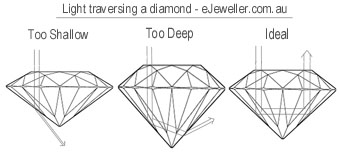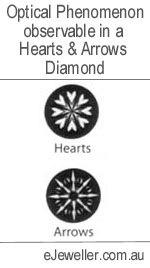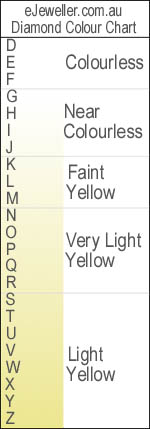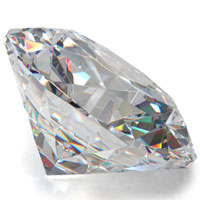eJeweller.com.au has produced this section to provide you with a fair understanding of diamonds so you can make a more informed purchasing decision. The 4Cs of diamonds are the criteria used by diamond professionals to classify, grade and value loose diamonds. Each of the 4 Cs is described in detail below. If you require further clarification of any aspect please contact us.
Diamond Carat
This is the simplest of the 4Cs and the only ‘C’ that is not subjective.
So what is a Carat?
A Carat or ct. is just a unit of measure for the weight of the diamond. It has nothing to do with Carat/Karat as in 9 carat/karat or 18 carat/karat gold which is a unit of Gold Purity. To learn about gold carats/karats click here.
One carat is equivalent to 200mg = 0.2 grams = 1/5th of one gram. ie 5 carats = 1 gram. Given that it is measured with precise weight scales there is no need for human judgement. One carat is further broken up into 100 points. ie a 50 point diamond is 50/100 carats ie half a carat. Similarly a 0.10 carat diamond is the same as a 10 point diamond or a ’10 pointer’.
Carat Weight, Price & Size

Price does not increase proportionally with carat size. For example a 1 carat diamond does not cost twice as much as a half carat diamond, nor 4 times as much as a 25 point diamond. It costs much more because as the size of a diamond increases so does its rarity. For example, at eJeweller.com.au we may offer a certified 1/2 carat diamond for around a third of the price of a 1 carat diamond of comparable quality.
Furthermore, when viewed from the top don’t expect a 2 carat diamond to look twice as big as a 1 carat diamond. The chart on the right is a guide to increases in diameter in well-cut diamonds. As can be seen in the scale, a 2 carat round brilliant cut diamond will have a diameter at the girdle of approximately 8.2mm and a 1 carat diamond approximately 6.5mm. What you view when looking top down at a diamond is the apparent size. Meaning you can see the area of the top surface of the diamond but you cannot really see the volume of the diamond. Weight is directly proportional to volume so the 2 carat diamond has twice the volume of the 1 carat diamond. However, the apparent top-view size of the 1ct (6.5mm) diamond is approximately 33mm squared, while the apparent size of the 2 carat (8.2mm) diamond is about 53mm squared. In other words, the volume (and weight) have doubled, but the apparent size has increased only by 61%.
The diameter of a diamond will also depend on the cut quality to a certain extent. The sizes given in this table assume a well cut stone. Deep cut diamonds appear smaller than well cut (ie well proportioned) diamonds of the same weight and conversely shallow cut diamonds appear larger than ideal cut diamonds of the same weight. Read more on cut further down.
Diamond Prices & a Warning
Another thing to consider when purchasing a diamond is that there is a premium price when they reach and exceed each 1/4 carat level. As an example a 0.95 carat diamond will be cheaper per carat than a 1.00 carat diamond. ie there is a larger jump in price from 0.95 carat to 1.00 carat than there is from 1.00 to 1.05 even though in both cases the diamond is only 0.05 carats bigger. So to save a little money, when looking for a 75 point diamond for example, you may as well buy a 70 point diamond if one is available at a better price. Be warned that some large online retailers offer 1 carat diamond rings and in the fine print mention the stone could be a minimum of 0.98 carats. At eJeweller.com.au if a ring is described as 1 carat we guarantee you will get a 1 carat diamond ring and more often than not you will end up with 1.01 or 1.02 etc.
Diamond Cut – to be edited

Cut is commonly confused with shape. For a list of Diamond Shapes look to the list on the right. This is not an exhaustive list but shows the shapes that make up the vast proportion of diamond shapes sold today. The Round Brilliant Cut still remains most popular. The princess cut, which is gaining in popularity, almost matches the optical properties of the Round Brilliant Cut.
The true meaning of cut in a diamond grading context is the various proportions, symmetry and finish of the diamond. What makes evaluation of cut so difficult is that there is more than one way, and many opinions, as to how to cut a diamond to optimize its optical properties and hence maximize its brilliance and beauty.
Diamond Proportions

Proportion refers to the angles and relative measurements of a polished diamond. More than any other feature, proportions determine a diamond’s optical properties. Scientific studies have shown that table size, crown angle, and pavilion depth have a dramatic effect on a diamond’s appearance.
Given this, cutting a diamond to produce the greatest possible return of light to the observer depends on the interrelationship between these three components. There isn’t however just one specific combination of these three that will yield the most brilliant diamond. Various combinations of these proportions can potentially produce diamonds of equal brilliance and beauty.
Pavilion Depth

The diagram on the right only looks at pavilion depth (distance from the bottom of the girdle to the culet), one of the 3 major proportions affecting a diamond’s brilliance. A pavilion depth that is too shallow or too deep will allow light to escape from the side of the stone, or through the bottom, causing a dark and dull appearance and reducing the diamond’s brilliance. A well-cut diamond will direct more light through the crown thus maximising the brilliance of the diamond. Note that the diagram is an oversimplified 2-dimensional representation of the complex behaviour of light passing through the diamond which in reality includes refraction, dispersion and reflection.
Diamond Symmetry
Symmetry refers to the exactness of correspondence and alignment between facets of a diamond. Problems that diminish the symmetry of a diamond, usually due to poor or careless workmanship, are: off-centre table, off-centre culet, non-round or wavy girdle, non-parallel girdle, non-parallel table, table not a regular octagon, misaligned facets, misshaped facets, naturals and extra facets not graded under clarity. Poor symmetry can cause light to be misdirected as it travels into, through and out of the diamond.
Diamond Finish
Finish refers to the precision of the cut, the condition of the girdle and the diamond’s polish. The polish grade given to a diamond describes the smoothness of the facets. Poor polishing can dull the surface of the facet creating a dull sparkle. The diagram on the right outlines the various facets of a round brilliant cut diamond. Often the culet is left pointed and hence is not a facet, giving a total of 57 facets. The girdle is sometimes faceted but these facets are not counted in the normal way.
Hearts & Arrows

Hearts & Arrows is an optical phenomenon which can arise when a round brilliant cut diamond has been well cut. The diagram in the right margin illustrates the phenomenon which can be viewed with a symmetry viewer.
The Effect of Cut on Price & Size
Well cut diamonds cost more for 3 reasons. The first is that they look the most beautiful and hence are in greater demand. Secondly more skill was used and time was expended by the diamond cutter to get all the proportions and angles to fall within a desired range of values. Thirdly, and probably most importantly, a larger stone is required to cut a well-cut diamond than a poorly cut diamond of the same carat weight. ie you lose more of the diamond in the cutting process because the cutter concentrates not on getting the heaviest finished diamond out of the rough diamond, but rather the most brilliant diamond.
As an example, a well cut 1 carat diamond has a diameter of approx 6.5mm whereas a shallow cut 1 carat diamond will have a diameter greater than this and so appear larger when looked at from the top. This isn’t as good as it sounds because you will be sacrificing brilliance of the diamond for apparent size. These badly cut diamonds often have a dull lifeless look known as “fisheye”. Conversely a deep cut 1 carat diamond will have a diameter less than 6.5mm so you will be paying for a diamond that not only looks smaller than it should, but also doesn’t have the brilliance of a well cut stone. These stones often have a dark dull area in the centre which is a phenomenon known as “nailhead”.
Sacrificing 3 of the C’s
In conclusion, it is very important to consider only purchasing a well-cut diamond even if this is to the detriment of the other 3 C’s. The better cut will will make up for the lower clarity, colour and possibly size (carats) in brilliance and beauty. Indeed bigger is not always better. A diamond can have excellent colour, clarity and size, but if cut badly will lack brilliance and beauty.
What do we mean by well cut?
There are many terms used to indicate how well a diamond is cut. For round brilliant cut diamonds look for a “Cut” or “Proportions” grade of Excellent, sometimes called Ideal. Very Good and Good cut grades offer excellent value for money. Below these are Fair, Poor or Unspecified, be weary of these unless of course that is what you are after and you are not being charged a premium. NB that the above grades are usually only provided on certificates for Round Brilliant Cut stones. For fancy shapes you will have to rely on your own knowledge and the trustworthiness of the supplier.
NB The above sections have focused on the Round Brilliant Cut Diamond, but the most general principles apply to all fancy cut diamonds as well.
Diamond Clarity – to be edited
Diamonds, being a natural product, are subject to imperfections. Diamond Clarity grading is a system that has been developed to categorise and describe these imperfections. Refer to the chart on the right for a range of clarity grades used by the GIA (Gemological Institute of America)
Types of Imperfections on Diamonds
The internal imperfections are broadly called inclusions, and the surface irregularities are called blemishes. Taken together they are the ‘clarity characteristics’ of the diamond. The following lists categorise and explain the various imperfections found in diamonds:
Blemishes
- Abrasions – Small nicks on facet junctions or on the culet caused by wear or rubbing against other diamonds.
- Naturals – portions of the rough crystals surface left on the finished diamond usually in the girdle.
- Extra Facets – Small facets created to remove imperfections that are not part of the cutting style.
- Polish Marks – Surface clouding caused by excessive heating during polishing.
- Polish Lines – Small parallel lines left by irregular polishing.
- Surface Graining – Faint lines causing wavy or grooved surfaces due to irregularities in crystal growth.
- Rough Girdle – Caused by poor workmanship.
Inclusions
- Bearding – Small feathers extending inward from a bruted girdle surface.
- Cavities – Large/deep openings in the diamond’s surface.
- Chips – Small/shallow openings in the diamond’s surface, respectively.
- Clouds – Hazy or cloudy areas caused by numerous very small inclusions.
- Feathers – White and feathery cleavages or fractures.
- Fractures – Breaks along planes other than cleavage planes.
- Included Crystals – Mineral crystals, such as garnet or peridot, contained within a diamond.
- Indented Naturals – Natural rough surfaces that penetrate the stone and can distort the girdle’s outline.
- Internal Graining – Regions of irregular crystal growth appearing as milky or coloured lines & streaks. May also be reflective.
- Needles – Needle shaped included crystals.
- Pinpoints – Areas of minute pinpoint inclusions.
- Twinning Wisps – Clouded areas produced by distorted crystal formation.
- Laser Drill Holes – A minute tube made by a laser. Resembles a needle.
Whilst inclusions decrease the value of a diamond they are useful in that they allow a gemmologist to identify a diamond using the unique combination of its inclusions. Inclusions also make it possible to distinguish real diamonds from lab created simulants.
All other factors being equal, the higher up the chart a diamond’s clarity grade is the more valuable it is. Diamonds between the grades of VVS1 and SI2 represent the bulk of the retail market.
At eJeweller.com.au we use and offer diamonds ranging from IF (Internally Flawless) to SI2 (Slightly Included). Diamonds in the SI1-SI2 range represent exceptional value for money. As a rough guide a FL diamond in the range of 0.50 carat to 1.0 carat can cost 50% to 100% more than an otherwise identical SI diamond. So to save money whilst still getting a beautiful diamond at eJeweller.com.au we recommend the SI grade. An SI2 diamond will rarely have inclusions visible to the naked eye, and will be just as beautiful as a higher clarity diamond. This is especially so as you go down in size from 1ct.
Diamond Clarity Grades
- FL -Flawless Shows no inclusions or blemishes of any sort under 10X magnification when observed by an experienced grader.
- IF – Internally Flawless Has no inclusions when examined by an experienced grader using 10X magnification, but will have some minor blemishes.
- VVS1 & VVS2 – Very Very Slightly Included Contains minute inclusions that are difficult even for experienced graders to see under 10X magnification.
- VS1 & VS2 – Very Slightly Included Contains minute inclusions such as small crystals, clouds or feathers when observed with effort under 10X magnification.
- SI1 & SI2 – Slightly Included Contains inclusions (clouds, included crystals, knots, cavities, and feathers) that are noticeable to an experienced grader under 10X magnification.
- I1, I2, 13 – Included Contains inclusions, possible large feathers or large included crystals) that are obvious under 10x magnification and may affect transparency and brilliance.
Diamond Colour – to be edited
For the following discussion please refer to the table on the right to visualize the diamond colour corresponding to each letter of the scale.

Colour Scales
In general, the less colour a diamond has, the greater its value. Colours range from colourless (D) to light yellow (Z).
D – Absolutely colourless, extremely rare diamond.
E & F – Still considered colourless, slight colour detectable by an expert. Also a rare diamond.
G & H – Colour is noticeable when compared alongside a colourless diamond.
I & J – Colour is slightly noticeable.
K to Z – Obvious and increasing amount of colour, diamonds less valued than the ones above. After Z, as we move into the fancies, the diamond value starts to increase again. We do not use or supply diamonds in this range at eJeweller.com.au.
Z+ – Diamonds in this colour range are called fancies. The most rare and expensive fancy colours are Red and Green. Other colours include Purple, Orange, Pink, Yellow and Black. Fancy diamonds are graded on a different system with colour grades such as: faint, very light, light, fancy light, fancy, fancy intense, and fancy dark.
When mounted in jewellery, even G, H, I and J diamonds can appear colourless (especially when set in yellow gold as opposed to white gold). It takes a highly trained eye to notice the slightly yellow/brown tinge in them. For diamonds less than half a carat that have been mounted in jewellery it is almost impossible for the untrained eye to detect colour up to I. However the colour is there and has an impact on the value of the diamond.
Colourless diamonds are extremely rare, and hence expensive, so most diamonds in jewellery are ‘near colourless’ with extremely faint yellow/brown tints. Despite the tint, ‘Near Colourless’ diamonds are considered to fall within the ‘normal’ colour range. At eJeweller.com.au we use and supply diamonds within the normal colour range but concentrate on the F – H range for our online jewellery pricing which gives an excellent quality/value combination.
Diamond colour can be affected by treatments such as HPHT (High Pressure, High Temperature Treatment) and Irradiation. Fluorescence can also affect colour.
Fluorescence
Fluorescence is produced when UV light (eg. from the sun) hits a diamond. It occurs in over 30% of gem-quality diamonds. The UV light causes excitation of electrons in the diamond crystal producing a usually blue light in varying intensities. When the UV source is removed so does the effect. The reason you should know about fluorescence is that if strong it can alter the colour you perceive a diamond to be; ie strong fluorescence can in some cases make top range colours (D – H) appear slightly cloudy (a negative) whilst making lower grades (I – Z) appear to have less yellow colour than they actually do (a positive). When buying a Diamond that has fluorescence, make sure that it is blue and no other colour. If blue, it won’t be a factor in the stone’s appearance unless the intensity grade is strong or greater. Even in these cases it is rarely a problem and can in some cases be a positive as described above.
Diamond Colour Treatments
High Pressure/High Temperature (HPHT) treatment
With this annealing process diamonds of low colour can be converted to (D-H) colour. The technique has also been applied to Brown diamonds to yield other fancy colours. Research shows that diamonds that have undergone these treatments can be detected by sophisticated instruments.
Irradiation
This is a technique which uses a nuclear reactor to produce fancy coloured diamonds.
NB: At eJeweller.com.au we do not use any diamonds that have undergone treatments.
Diamond Colour’s Effect on Price
As a very general rule of thumb you can expect a 1 carat diamond of J colour to be 40-50% cheaper than the same diamond in a D colour.
How to Save Money on a Diamond – to be edited
After reading and digesting all of the above information you are now in a better position to make a diamond purchase. Whether you buy your diamond from us at eJeweller.com.au or elsewhere we urge you to keep the following tips in mind, they could save you some money.
Don’t get hung up on the nice round numbers like 0.50 carat 0.75 carat and 1.00 carat etc. You can often save a few dollars by purchasing 0.48 carat, 0.73 carat, and 0.99 carat. No human can tell the difference between a 0.99 carat and a 1 carat diamond, yet you’ll be saving more than 0.01 carat difference because there is usually a disproportionate jump in price when diamond sizes reach these ‘milestone’ sizes.
Further savings can be made by not going for the top colour. Unless you are a purist, or have unlimited money, there really is no reason to buy a D colour diamond given the premium price you must pay. Buying E or F colour will give you a small saving, whilst buying a G or H colour diamond will save you a lot. Bear in mind that G – J colour diamonds are still considered near colourless. A G-H colour is still quite a high colour grade so you don’t compromise too much on quality whilst making a substantial cost saving. With I to J you can make further savings but at this point the yellow colour is slightly noticeable in a white gold ring setting, however, if the diamond is to be set in a yellow gold ring or jewellery it will be unnoticeable to the untrained eye. Savings of up to 50% can be made dropping from colour D to colour J on a 1 carat diamond.
Clarity is another potential money saver. Slight inclusions/impurities in the diamond don’t really have a major effect on the path of light through it until you get into the heavily Included grades (I1, I 2, & I3). This means that brilliance of a diamond isn’t greatly affected when going from FL (Flawless) Grade to SI2 (Slightly Included) Grade. You are better off making a saving here and using the money to purchase as good a cut as you can afford. As an example you can save up to 50% by dropping from a clarity of FL to SI when considering a 1 carat well cut diamond.
Cut is one area where we do not recommend you make a saving. A very badly cut diamond will look dull and lifeless no matter how many carats it is, how good a colour grade it has, and how much clarity it has. Whilst you can compromise on the other 3 Cs you should really not compromise on Cut. Insist on a cut of at least Good, Very Good is even better, and if you can afford it Excellent (sometimes called Ideal). You will be glad you make this decision.
So, if for example you were looking to buy a 1 carat Internally Flawless, D colour Diamond you could make very substantial savings without a noticeable loss of beauty, by instead opting for a 0.95 carat, H colour, SI2 diamond. The huge savings could then be used to try and obtain the best cut you can afford, for example VG or EXC cut. This would give you, in our opinion, a most beautiful diamond at an affordable price.
At eJeweller.com.au we stock and use GIA certified Diamonds.
Email us for pricing on a loose certified diamond.
Don’t hesitate to contact us for further explanation of any of the above topics.
Glossary of Diamond Related Terms & Phrases
- Bruting – the first process of cutting a diamond by shaping its girdle
- Optical Properties – the properties that determine light’s interaction with the diamond.
- Brilliance – the combination of all the reflections of light from the surface and from within the stone giving a stone its brightness.
- Dispersion – also referred to as fire, the separation of white light into its spectral (rainbow) colours caused by refraction, ie each colour having a different wavelength to the others, will refract a little differently leading to the separation of individual colours.
- Scintillation – also referred to as sparkle, tiny flashes of light observed with movement of either the light source, the diamond or the observer’s eye.
- Fancy Cuts – Shapes other than the standard round brilliant cut are referred to as fancy shapes or cuts
More Diamond Facts
- Diamond’s tight crystalline structure slows light down like no other substance can.
- Light inside a diamond travels at less than half its speed through a vacuum.
- Diamond is the hardest naturally occurring substance.
- Diamond is a crystallized carbon mineral.
